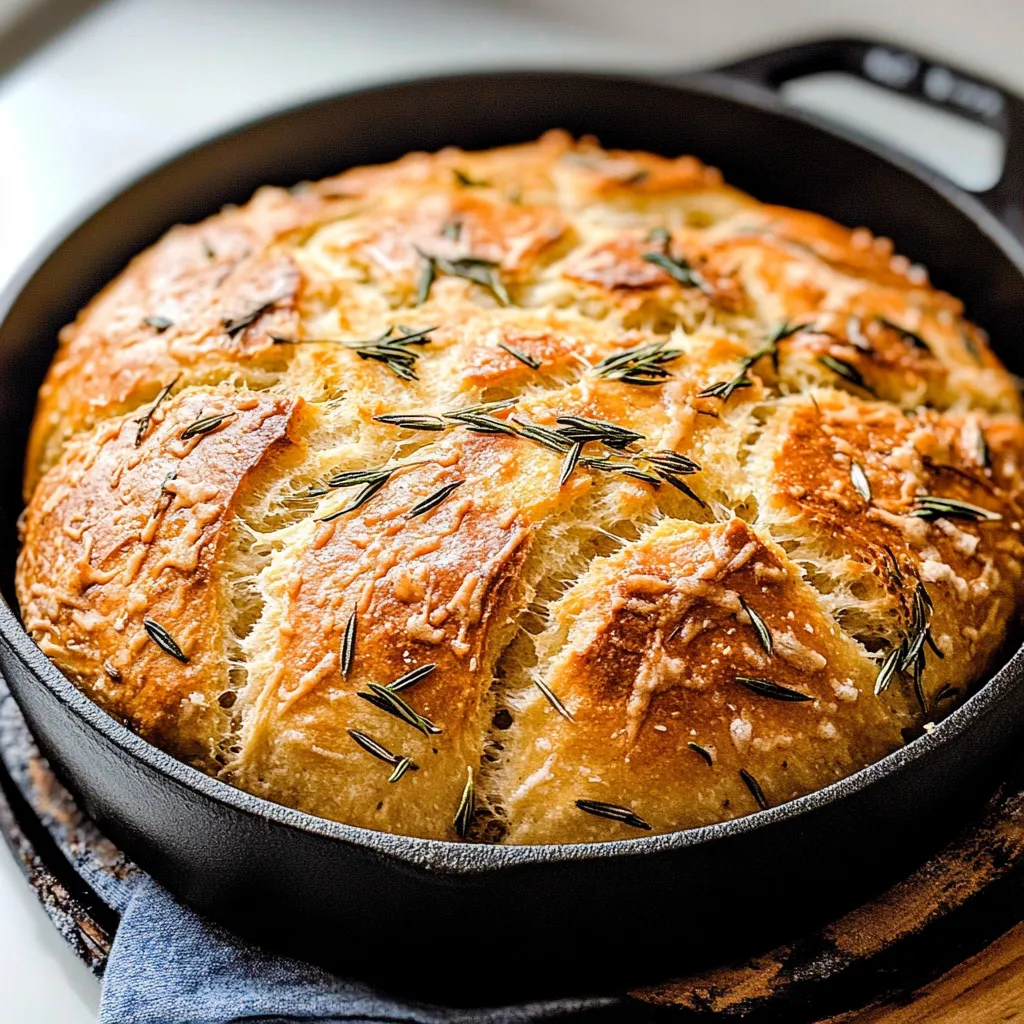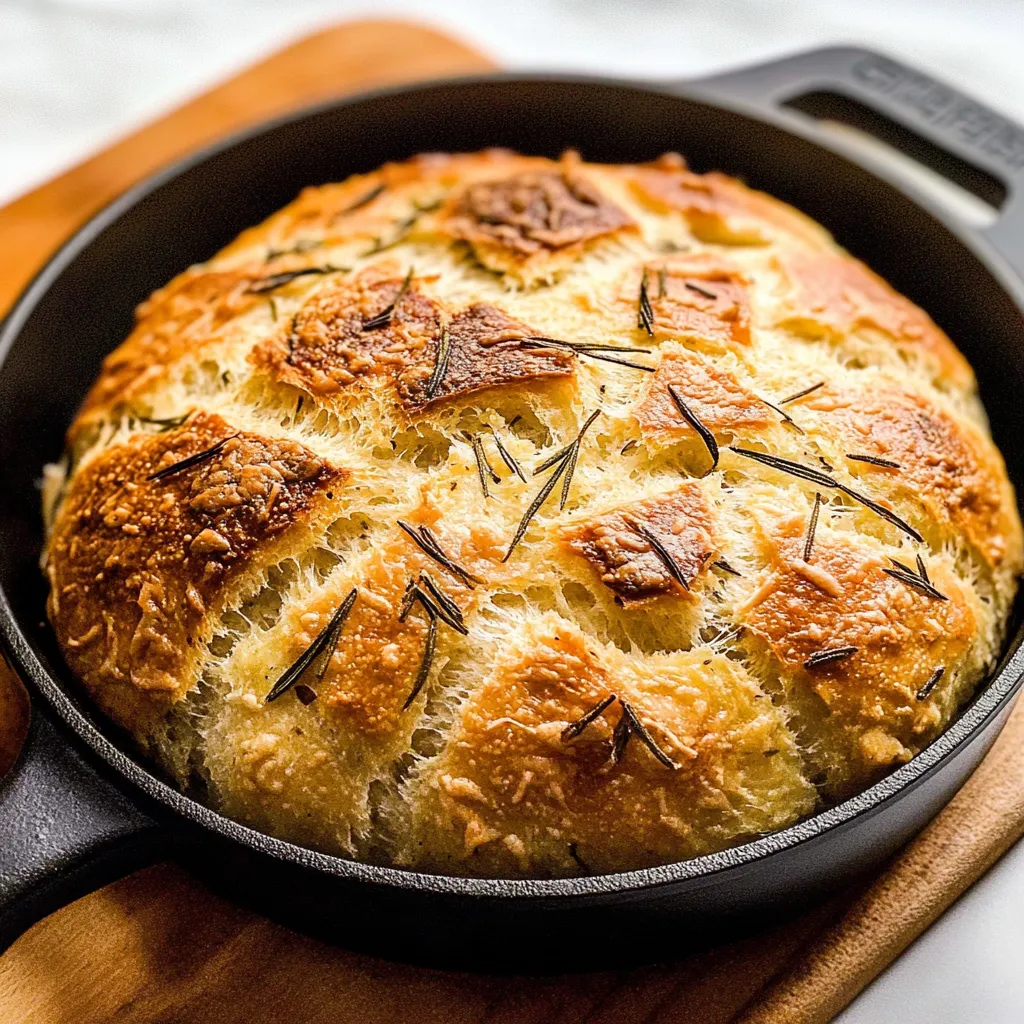 Pin
Pin
This rustic No Knead Rosemary Parmesan Skillet Bread transforms basic pantry ingredients into a bakery-worthy loaf with minimal effort. The crispy, cheesy crust paired with the fragrant rosemary interior creates an irresistible combination that makes you look like a professional baker with hardly any work.
I discovered this bread recipe during lockdown when yeast was scarce and my baking skills were limited. What started as a necessity has become my go-to impressive side dish whenever I want to elevate a simple meal without much extra effort.
Ingredients
- All-purpose flour: Creates the perfect texture. Be sure to measure correctly by spooning into measuring cups and leveling off for best results
- Instant yeast: Allows for quicker rising time without proofing first. Check expiration date for freshness
- Fresh rosemary: Provides aromatic flavor throughout the bread. Choose bright green sprigs for maximum flavor
- Fine salt: Enhances all the flavors and strengthens the gluten structure
- Olive oil: Adds richness and helps create that crispy exterior. Use a good quality olive oil for best flavor
- Parmesan cheese: Creates an irresistible crispy cheesy crust. Freshly grated works best rather than pre-packaged
Step-by-Step Instructions
- Mix the Base:
- Combine yeast with lukewarm water in a large mixing bowl. The water should feel just barely warm to touch around 100°F. Add half the flour and stir with a wooden spoon until combined. This creates a wet starter base that activates the yeast quickly.
- Complete the Dough:
- Add the chopped rosemary, salt, and remaining flour to the bowl. Stir until completely combined. The dough will look shaggy and feel sticky this is exactly what you want for a no knead bread. Cover the bowl with plastic wrap and let rise in a warm spot until doubled in size, approximately one hour.
- Prepare the Skillet:
- Brush 2 tablespoons olive oil generously across the bottom of a 10 or 12-inch cast iron skillet. The oil prevents sticking and helps create that amazing crispy bottom crust. The cast iron retains heat beautifully for even baking.
- Shape and Second Rise:
- Sprinkle flour over the dough and on your hands to minimize sticking. Gently shape the dough into a rough disk without overworking it. Place it in the oiled skillet. Don't worry about perfect shaping as rustic looks authentic. Cover loosely and let rise until puffy, about 30 minutes.
- Bake to Perfection:
- Preheat oven to 400°F. Drizzle the remaining olive oil over the top of the risen dough. Using a sharp knife, slash an X shape in the top which allows for proper expansion. Sprinkle additional rosemary leaves across the surface. Bake for 20 minutes to establish the crust.
- Add Cheese Finish:
- Remove the partially baked bread from the oven and sprinkle the Parmesan cheese evenly across the top. Return to the oven and bake for another 20 minutes until deeply golden brown. The cheese will create an irresistible crispy topping that makes this bread special.
 Pin
Pin
I particularly love how the rosemary releases its essential oils during baking, filling the kitchen with the most amazing aroma. My daughter now associates this smell with special family dinners, always exclaiming "It smells like celebration!" whenever this bread is in the oven.
Make-Ahead Options
This forgiving dough can be prepared up to 24 hours in advance and stored in the refrigerator after the first mixing. The slow, cold fermentation actually improves flavor development, creating a more complex taste profile. Simply remove from the refrigerator about an hour before you plan to shape and bake to allow it to come to room temperature.
Perfect Pairings
This bread shines alongside hearty soups and stews, where its sturdy texture stands up to dipping. Try serving it with olive oil and balsamic for a simple appetizer, or use it as the base for elevated bruschetta with fresh tomatoes and basil. The rosemary flavor complements Italian dishes particularly well, making it perfect alongside lasagna or osso buco.
Troubleshooting Tips
If your bread doesn't rise properly, your yeast may be expired or your water temperature could be too hot or too cold. Lukewarm water around 100°F activates yeast without killing it. Also check that your rising environment isn't too drafty or cold, which can slow or prevent proper rising.
Flavor Variations
While the rosemary and Parmesan combination is classic, this versatile recipe welcomes creative adaptations. Try substituting fresh thyme or oregano for the rosemary, or add minced garlic for extra flavor. The Parmesan can be swapped for other hard cheeses like Pecorino Romano or Asiago. For a Mediterranean twist, fold in chopped olives and sun-dried tomatoes before the second rise.
Recipe FAQs
- → How do I ensure my dough rises properly?
Make sure your water is lukewarm (around 100°F) and keep the dough covered in a warm environment for the recommended time.
- → Can I use dried rosemary instead of fresh?
Yes, you can substitute dried rosemary, but use half the amount as dried herbs are more concentrated in flavor.
- → What should I do if my dough is too sticky?
Add a bit more flour, a tablespoon at a time, to reduce stickiness, but avoid over-flouring to maintain a soft texture.
- → Is it necessary to use a cast iron skillet?
While a cast iron skillet provides the best crust and bakes evenly, you can use an oven-safe baking dish as an alternative.
- → When should I add the parmesan cheese?
Add the parmesan cheese halfway through baking to maintain maximum cheesy flavor and texture in the crust.
No Knead Rosemary Parmesan Bread
Delicious rosemary parmesan bread with crispy crust. Easy to make and full of flavor.
What You’ll Need to Make This
→ Dough Ingredients
How to Prepare
In a large mixing bowl, combine the yeast and water. Add half the flour and stir with a wooden spoon. Blend in the rosemary, salt, and remaining flour until thoroughly combined. Cover the dough with plastic wrap and let it rise in a warm location for 1 hour until doubled in size.
Brush 2 tablespoons of olive oil onto the bottom of a 10- or 12-inch cast iron skillet. Sprinkle flour onto the dough and your hands, then shape the dough into a rough disk. Place the dough into the skillet, cover loosely, and let it rise for 30 minutes until puffy.
Preheat the oven to 400°F. Drizzle the remaining olive oil over the top of the dough. Use a sharp knife to slash an X into the surface. Sprinkle with additional rosemary leaves and bake for 20 minutes.
Remove the skillet from the oven and sprinkle the bread evenly with Parmesan cheese. Return it to the oven and bake for an additional 20 minutes, or until the crust is golden brown.
Tools Required
- Large mixing bowl
- Wooden spoon
- Cast iron skillet (10 or 12-inch)
- Plastic wrap
- Sharp knife
Allergen Info
Review ingredients carefully for allergens. Reach out to your healthcare provider if you’ve got specific concerns.
- Gluten
- Dairy
Nutritional Information (Per Serving)
Remember, this info is purely for reference and isn’t meant to replace dietary guidance.
- Caloric Value: 320
- Fat Content: 10 grams
- Carbohydrate Content: 45 grams
- Protein Content: 8 grams
